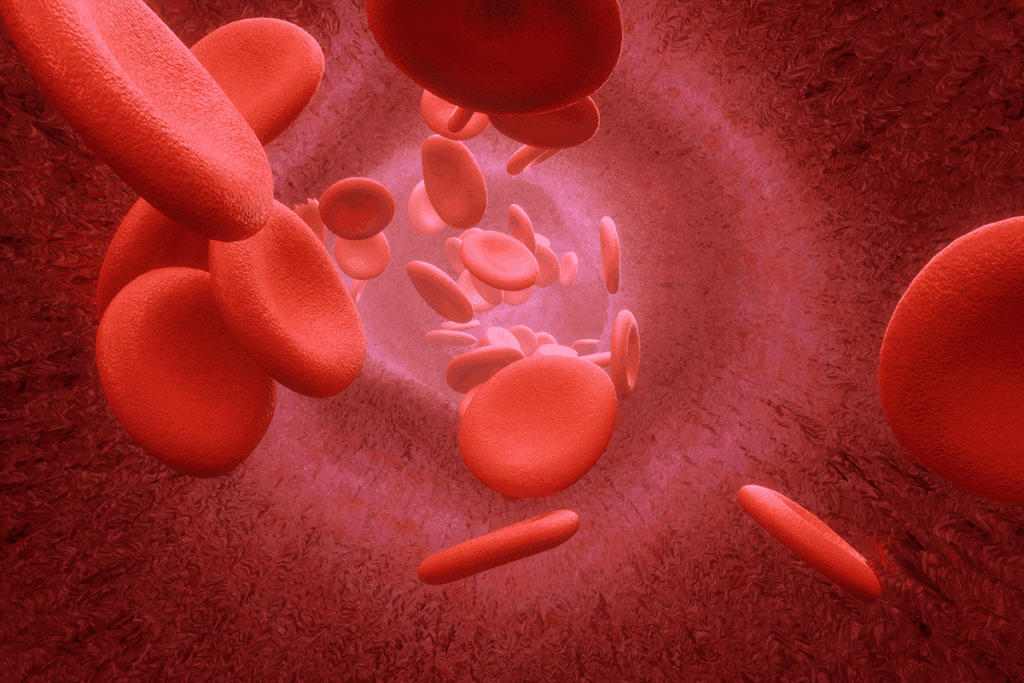
Understanding physiologic anemia of infancy is key for good pediatric care. This condition is a normal drop in hemoglobin concentrations in all babies.
Liv Hospital is known for its trusted care. They focus on accurate diagnosis and evidence-based treatment for families around the world. The drop in hemoglobin levels in newborns is a big part of this condition.

Newborns often see a normal drop in hemoglobin levels, called physiologic anemia of infancy. This is a natural part of growing up and happens in most babies.
Physiologic anemia of infancy is when hemoglobin levels go down after birth. This is because the baby’s body adjusts to the new oxygen environment. It leads to fewer red blood cells and lower hemoglobin levels. This is a normal step in development and usually gets better on its own.
Physiologic anemia of infancy is also called physiological anemia of infancy and anemia of prematurity in preterm babies. These names are used the same way, but might mean slightly different things depending on the situation.
Research shows that physiologic anemia is common in newborns. In Africa, about 30.52% of newborns have anemia. In healthy babies, this is usually not a worry and is just a normal part of growing up.
Here are some important facts about physiologic anemia of infancy:
It’s important to know about physiologic anemia of infancy to tell it apart from other types of anemia that might need treatment. By understanding this normal part of development, doctors can give parents the right advice and reassurance.

To understand infant anemia, we must look at how the body changes from being in the womb to being outside. This change affects how red blood cells are made.
When a baby is born, its blood system changes. It moves from a low-oxygen to a high-oxygen environment. This change makes less erythropoietin, a hormone that helps make red blood cells.
More oxygen after birth means less erythropoietin. This leads to fewer red blood cells being made. This is a main reason for infant anemia. It’s usually temporary as the baby’s body adjusts.
Fetal red blood cells don’t last as long as adult ones. When they die, they’re not replaced as quickly because of less erythropoietin. This causes a temporary anemia.
These changes cause a drop in hemoglobin levels in babies, usually seen at 6-12 weeks. Knowing about these changes helps doctors tell if a baby’s anemia is normal or not.
Hemoglobin levels in term newborns follow a predictable pattern. This helps in diagnosing physiologic anemia. At birth, the hemoglobin level is high because of fetal hemoglobin.
The average hemoglobin level in term newborns at birth is 14 to 24 g/dL. The mean is around 19 g/dL. This high level supports the fetus during gestation.
After birth, the hemoglobin level gradually decreases. This is because red blood cells with fetal hemoglobin are broken down. They are replaced by adult hemoglobin.
This decline is a normal physiological process. Several factors influence it, including:
The hemoglobin level reaches its lowest point, known as the physiological nadir, between 8-12 weeks of age. For term infants, this nadir is usually between 9 to 11 g/dL.
As erythropoiesis resumes and red blood cell production increases, the hemoglobin level starts to rise. Understanding these normal hemoglobin ranges is key. It helps in telling apart physiologic anemia from pathological anemia in newborns.
Preterm infants have unique hemoglobin patterns compared to full-term babies. Their lower initial hemoglobin levels, shorter red blood cell life, and less erythropoietin production cause these differences.
Preterm babies hit a lower point in their hemoglobin levels sooner than full-term babies. While full-term babies usually reach a nadir of 9-11 g/dL, preterm babies can drop to 8-10 g/dL. This bigger drop is because of their lower starting hemoglobin and less erythropoietin.
The age at birth affects a preterm baby’s hemoglobin levels. Babies born earlier have lower hemoglobin and a bigger drop. This shows why birth age is key when looking at hemoglobin in preterm babies.
Preterm babies take longer to get back to normal hemoglobin levels. This is because they need more time to grow and face challenges in making new red blood cells. Knowing this helps doctors plan better care and act when needed.
To wrap up, preterm infants have a deeper nadir, a link between birth age and hemoglobin, and a longer recovery. These points stress the need for close monitoring and special care for preterm babies.
Physiologic anemia of infancy has a clear timeline that doctors need to know. It’s a normal part of a baby’s growth, mainly in the first few months.
At birth, babies have high hemoglobin levels because of fetal hemoglobin. As they start living outside the womb, these levels start to go down.
The lowest point, or nadir, happens between 6 to 12 weeks. For healthy term babies, this nadir is usually when hemoglobin is 9 to 11 g/dL.
After the nadir, the body starts making more erythropoietin. This helps increase hemoglobin levels. This recovery is key for the baby to adjust to life outside the womb.
Physiologic anemia of infancy usually goes away by the first year. The exact time can depend on things like how early the baby was born and their diet.
The main points in the timeline of physiologic anemia of infancy are:
Knowing this timeline helps doctors tell the difference between normal anemia and serious conditions that need treatment.
It’s important to know if an infant’s anemia is normal or not. Physiologic anemia of infancy is a common condition after birth. But, it’s key to tell it apart from pathological anemia to get the right treatment.
Physiologic anemia usually doesn’t show any symptoms. Infants with it don’t seem to be in distress. On the other hand, pathological anemia can cause pallor, tachycardia, and poor feeding. These signs might mean the anemia is not just normal.
Some signs can point to pathological anemia in infants. Look out for:
Some conditions can make physiologic anemia worse. These include:
| Condition | Effect on Physiologic Anemia |
| Premature birth | Earlier and more profound nadir |
| Infections | Can worsen anemia due to increased erythropoietin suppression |
| Nutritional deficiencies (e.g., iron deficiency) | Can exacerbate anemia by limiting red blood cell production |
Healthcare providers need to understand these points. It helps them tell normal anemia from the pathological kind. This ensures the right care for infants.
Diagnosing infant hemoglobin involves both clinical checks and lab tests. This method is key to spotting normal anemia and differentiating it from serious conditions.
Screening for infant hemoglobin usually starts with a complete blood count (CBC) at birth and later. The timing depends on the baby’s age and risk factors.
Lab tests for checking infant hemoglobin levels include:
Understanding CBC results is important. It helps spot normal anemia in infants. Key points to look at are:
Other factors to think about when checking infant hemoglobin levels include:
Healthcare providers use these details to manage anemia in infants effectively.
It’s important to understand the clinical implications of physiologic anemia for effective management. Physiologic anemia of infancy is a normal part of development. But, it’s key to know the difference between this and pathological anemia.
In healthy term and preterm infants, mild anemia usually doesn’t need treatment. The CDC guidelines suggest observing and monitoring hemoglobin levels and overall health.
Medical help is needed if the anemia is severe or if the infant shows signs of distress. The decision to intervene depends on the infant’s health, anemia severity, and any underlying conditions.
For cases where symptoms are present, treatment might include iron supplements or blood transfusions. The choice depends on the anemia’s cause and the infant’s condition.
Follow-up care is vital to track the resolution of physiologic anemia and address any new issues. Regular visits to a healthcare provider are recommended to monitor hemoglobin levels and overall health.
| Condition | Management Approach | Follow-up |
| Mild Anemia | Observation | Regular check-ups |
| Severe Anemia | Medical Intervention (e.g., iron supplementation, blood transfusion) | Frequent monitoring |
Managing physiologic anemia in infants is possible with the right steps. It’s important to focus on good nutrition and keeping an eye on iron levels.
Nutrition is key in treating and preventing physiologic anemia. Infants on iron-fortified formula have different iron levels than those who are breastfed.
The American Academy of Pediatrics suggests iron supplements for those not on iron-fortified formula.
Iron supplements are a major part of preventing anemia. The advice is to start iron supplements at 4-6 months old.
| Age | Iron Supplementation |
| 0-4 months | No supplementation |
| 4-6 months | Start supplementation |
| 6-12 months | Continue supplementation |
Breastfed babies might need extra iron, mainly if they don’t get iron-rich foods.
“Human milk is generally low in iron, but the iron it contains is highly bioavailable.”
Teaching parents about iron-rich foods and supplements is vital. They should know the signs of anemia and the need for regular check-ups.
Physiologic anemia of infancy is a normal drop in hemoglobin in all babies. It happens as they move from fetal to postnatal circulation. This change affects how red blood cells are made.
This type of anemia gets better by itself, without needing treatment. Knowing the normal hemoglobin levels and when this happens is key. It helps tell it apart from other kinds of anemia.
Doctors should know what makes this anemia worse, like being born early or not getting enough nutrients. Knowing it’s self-limiting helps doctors avoid unnecessary treatments. It also reassures parents.
In short, physiologic anemia of infancy is a natural condition that goes away by itself. Understanding it and knowing how to tell it from other anemias is vital. This helps in giving the right care to babies.
Physiologic anemia of infancy is a common condition in newborns. It happens when hemoglobin levels drop after birth. This condition usually gets better on its own within a few months.
It’s caused by the change from fetal to postnatal circulation. Changes in oxygen and erythropoietin levels also play a role. These changes lead to less red blood cell production and lower hemoglobin levels.
Term newborns start with hemoglobin levels between 14-20 g/dL. These levels drop to 9-11 g/dL around 6-12 weeks. Then, they go back to normal.
Preterm babies see a bigger drop in hemoglobin levels, often to 8-10 g/dL. They also take longer to get back to normal.
It starts right after birth, with hemoglobin levels falling over the first few weeks. The lowest point is around 6-12 weeks. Then, it takes several months to recover.
Doctors use lab tests, like complete blood count (CBC), to diagnose it. They might also look at reticulocyte count and erythropoietin levels.
Usually, it doesn’t need treatment and just needs watching. But sometimes, doctors might need to give iron or blood transfusions.
To prevent it, focus on good nutrition, like enough iron. Parents should also learn about it. Sometimes, iron supplements are needed.
Physiologic anemia is normal, while pathological anemia is caused by illness. Doctors must tell them apart to give the right treatment.
Be worried if your baby looks pale, is tired, or won’t eat well. Talk to your doctor if you’re concerned about your baby’s anemia.
https://www.sciencedirect.com/science/article/abs/pii/S0022347671800768
Subscribe to our e-newsletter to stay informed about the latest innovations in the world of health and exclusive offers!